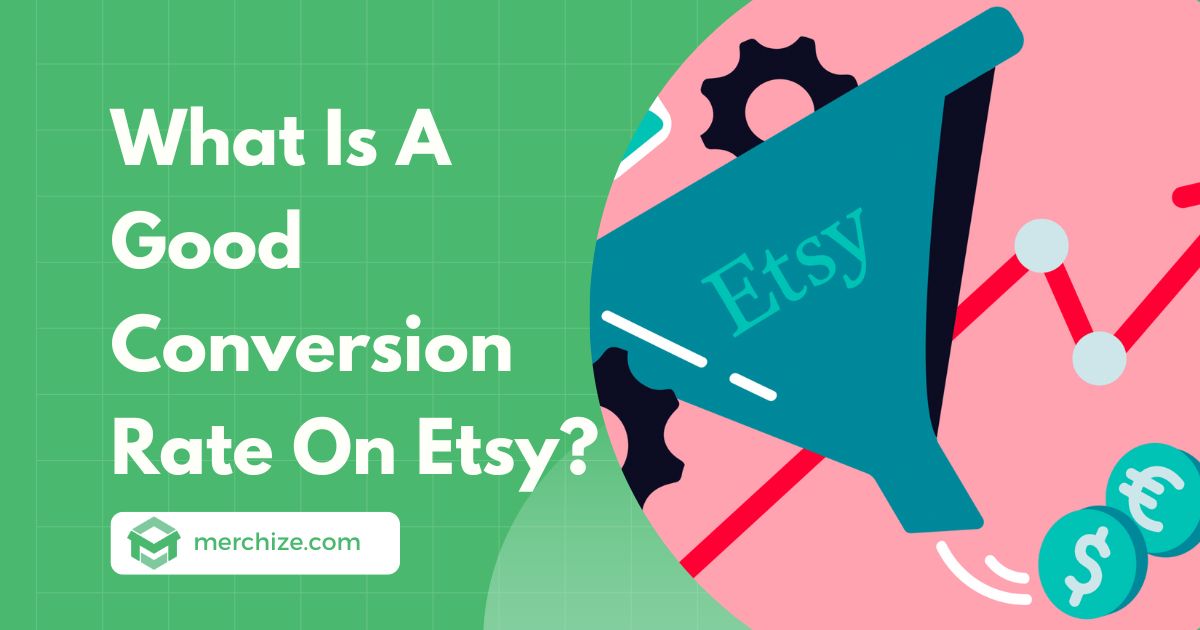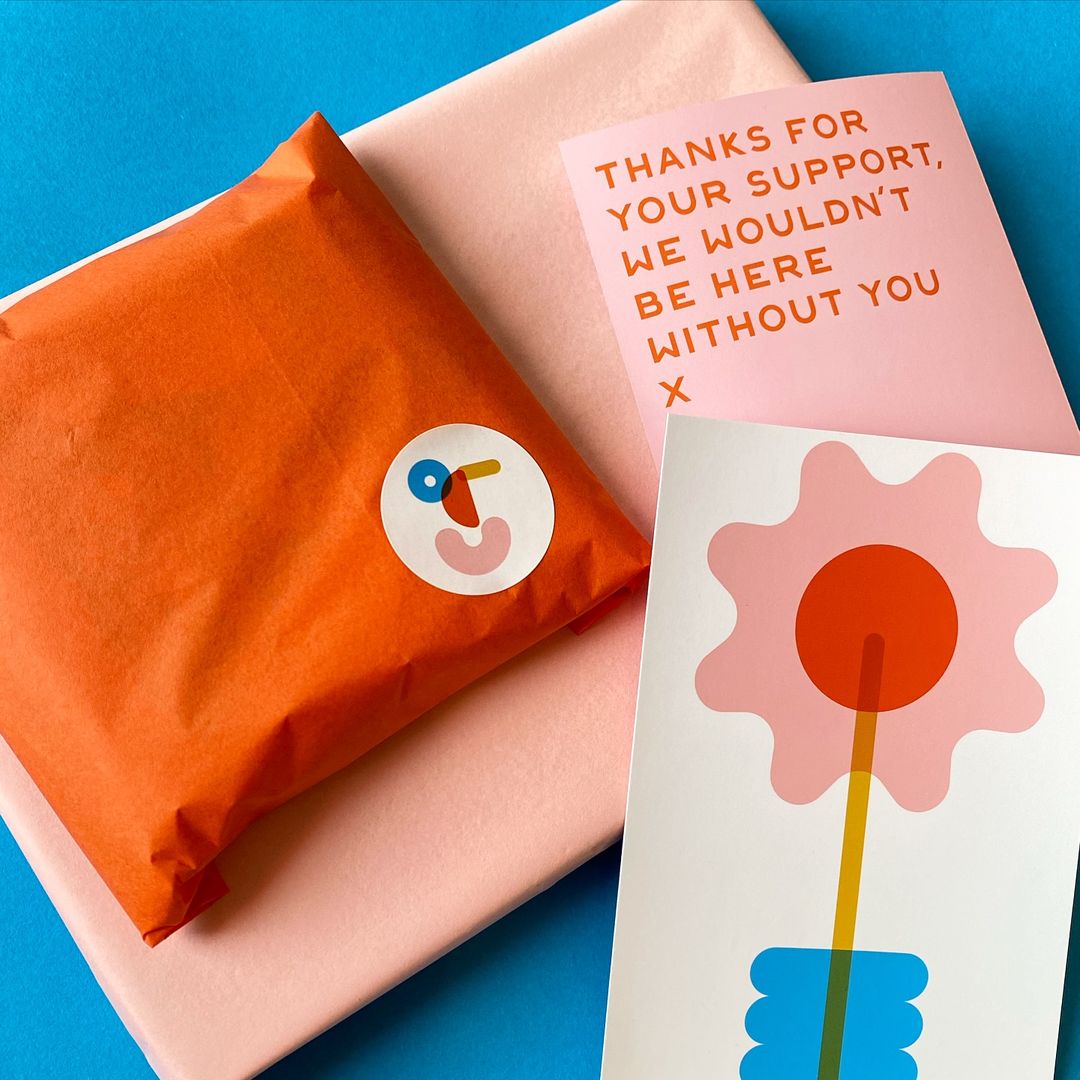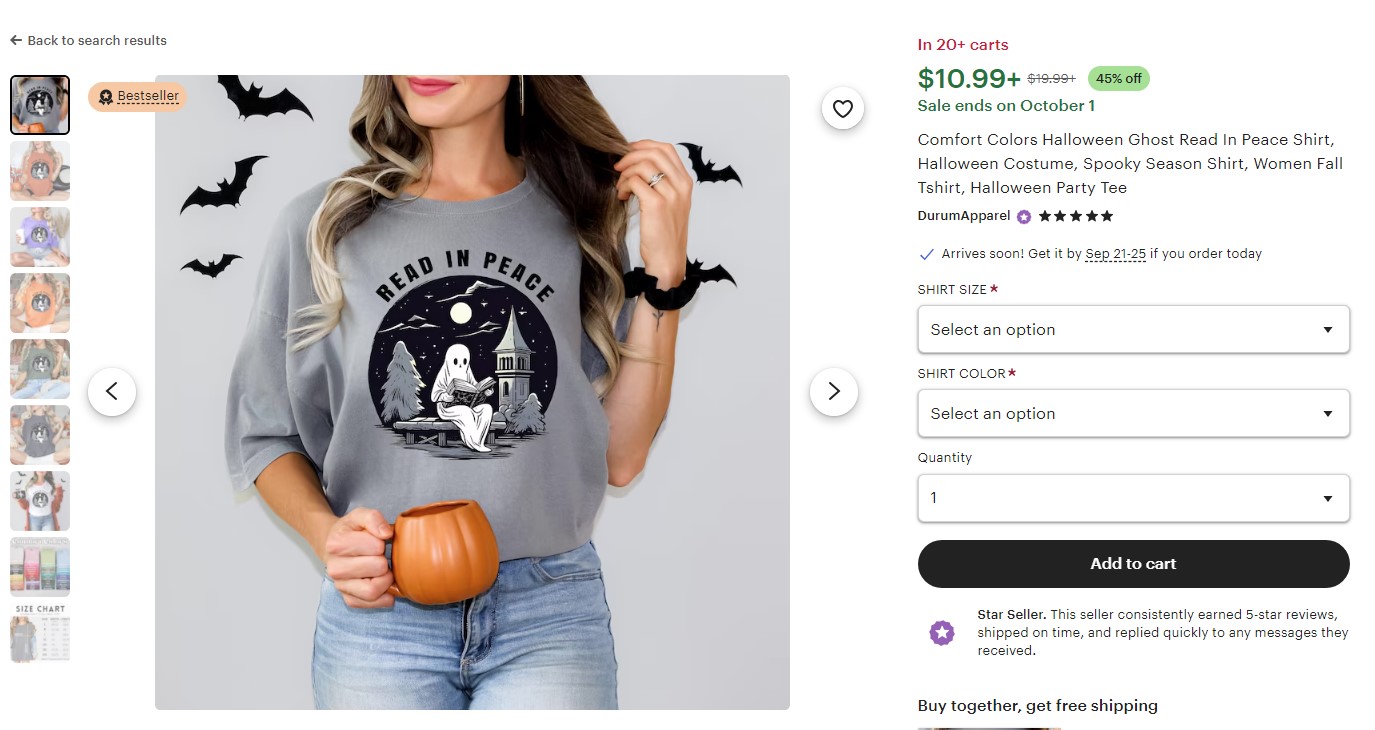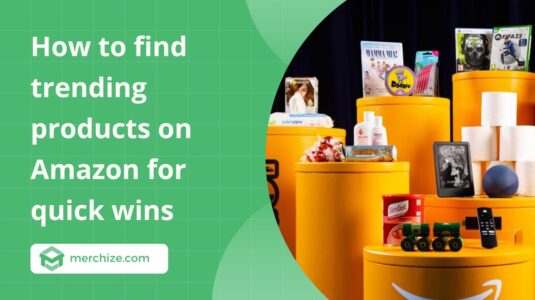Contents
What percentage of your Etsy shop visitors complete a purchase? But what qualifies as a “good” conversion rate? In this article you will know that, we analyze how to accurately track your shop’s conversion rate. You’ll learn easy tips to calculate your current rate, analyze how it stacks up, and implement targeted strategies to boost conversions. Monitoring and optimizing this key metric can transform more Etsy traffic into sales and take your shop to the next level.
What is a good Conversion Rate on Etsy?
According to research by Etsy sellers, the average Etsy conversion rate ranges between 1-3%. However, benchmarks vary greatly depending on product category and target audience. For example, conversion rates for custom handmade goods tend to be lower than mass-produced items.
In general, sellers should expect a conversion rate between 1–5%, though the overall benchmark to aim for is at least 2-3% for best performance. This aligns with the average ecommerce conversion rate of 2.61% according to Monetate. Achieving at least a 2-3% conversion rate helps ensure your Etsy shop is performing well compared to the broader ecommerce landscape.
For Etsy specifically, conversion rates tend to fluctuate more than a typical online store due to the handmade, vintage and customizable nature of many items. External factors like algorithm changes can also uniquely impact Etsy conversions. While there is no universal “good" conversion rate, excelling above 3% puts your Etsy shop ahead of the curve. Across Etsy, anything above 4% is an excellent conversion rate to strive for.
How do you calculate conversion rate on Etsy?
Calculating your Etsy conversion rate is simple – it’s the number of sales divided by the number of visits to your shop, multiplied by 100 to get a percentage.
For example, if you had 5 sales in a month and 200 visits, your conversion rate would be:
(5 sales ÷ 200 visits) x 100 = 2.5% conversion rate
You can easily find these numbers to plug into the formula in your Etsy Shop Manager. Go to Listings and open the stats for each listing. You’ll see number of orders and number of visits for any date range.
Additionally, eRank and other Etsy analytics tools calculate your conversion rate automatically across your whole shop or individual listings. This saves you time so you can spend it optimizing this crucial metric instead. Tracking conversion rate over time shows how impactful your improvements are translating into more profitability and helping you make money on Etsy.
Why Conversion Rates Matter for Etsy Sellers
There are a few key reasons why conversion rates are so important for Etsy shops:
Conversion Rates Affect Your Shop’s Ranking
Etsy wants to feature shops that offer a great experience for buyers. So part of how Etsy decides to rank shops in search results is by looking at conversion rates. If you have a high conversion rate, Etsy sees that as a sign you have a shop buyers love – and will start ranking your listings higher!
For example, let’s pretend your friend started an Etsy shop selling friendship bracelets at the same time as you. But your shop has a 7% conversion rate and your friend’s shop only has a 3% conversion rate. Etsy’s algorithm will probably start showing your listings higher than your friend’s in search results because more visitors are actually buying from you.
Conversion Rates Show if Your Marketing is Working
Let’s say you make some cool posters and decide to run some ads on Instagram to get more people to visit your Etsy shop. But if those visitors come to your shop and don’t end up buying anything, then your conversion rate will be low. That would be a sign that your Instagram ads aren’t really working even though they’re driving traffic to your shop.
On the other hand, if you run the same Instagram ads but then have a high conversion rate – that’s awesome! It means your ads were successful in finding customers who were interested in purchasing your posters. Paying attention to conversion rates helps you know if your marketing efforts are paying off.
Conversion Rates Reveal Issues in Your Shop
Low conversion rates often mean there are problems in your Etsy shop that are preventing people from buying. Maybe your photos are blurry or don’t show enough detail. Or perhaps your product descriptions are confusing. If visitors aren’t converting into customers, take a closer look at your listings – are there ways you could improve them to get more sales?
For example, let’s say you sell handmade jewelry. You have a listing for a bracelet that gets 50 visits per week – so lots of people are coming to that page. But nobody has purchased that bracelet in months. Something about that listing clearly isn’t working if all those visitors aren’t buying! Time for a makeover on that listing.
Conversion Rates Measure Your Profitability
Let’s say you sell handmade mugs for $20 each. If you have a really high conversion rate, like 10%, that means for every 100 people who visit your shop, 10 of them buy a mug from you at $20 each. That would be $200 in sales from those 100 visits. But if you only have a 2% conversion rate, you’d only make 2 sales, or $40 from those 100 visits. So conversion rates directly impact your overall profits!
Conversion Rates Help You Set Prices
If your conversion rates are super low, maybe you need to rethink your pricing! Visitors might be interested in your products, but find them too expensive so not many are buying. Try running sales or offering lower-priced items. If your conversion rates improve, you’ll know your prices were likely too high before.
High Conversion Rates Attract More Shoppers
Here’s one you might not have thought of – high conversion rates will actually help your Etsy listings rank higher in Etsy search results over time! More buyers finding and purchasing your items signals to Etsy’s algorithm that your shop offers an awesome customer experience. As you climb up those search results pages, more and more shoppers will stumble across your shop and potentially convert to customers. It’s a nice cycle of conversion rate boosting your visibility leading to even higher conversion rates down the road!
Factors That Influence Etsy Conversion Rates
As a seasoned marketing pro, you know that conversion rates are pivotal to online success. On a platform like Etsy, where browsing shoppers need persuasion to become paying customers, understanding conversion factors is key to promote Etsy shop effectively. It’s also essential to understand how to avoid copyright infringement on Etsy, which can significantly impact your shop’s success if not handled correctly.
The following elements make or break an Etsy listing’s ability to translate clicks into sales:
Compelling Imagery
We both know the power of product photography in ecommerce. Clean, enticing photos inspire trust in potential buyers while lackluster ones damage credibility. Given the importance of images, it is critical for Etsy sellers to master the fundamentals like:
- High-resolution primary images (Etsy recommends 2,000px minimum for shortest edge)
- Properly exposed and color-balanced shots
- Captions that clearly state what is for sale
- Consistency between photos and actual products
Additionally, lifestyle images and graphic overlays can capture browser attention amid fierce marketplace competition. Test these advanced techniques to lift conversion rates.
Keyword Optimization
Even marketing veterans underutilize keyword optimization at times, but its impact on Etsy conversions cannot be overstated. Both listing titles and tags should target relevant search queries in exact match scenarios.
To illustrate, a handmade candle listing would have higher clickthrough and conversion rates with a title like “Lavender Vanilla Scented Soy Candle” instead of just “Candle.” Tags would then reinforce keywords like “lavender candle,” “vanilla candle,” and related scent and material terms.
Tactical Pricing Models
Etsy attracts buyers hunting for deals amidst a sea of independent sellers. Thus pricing tactics give proven leverage for conversions. Common examples include:
- Penetration pricing to gain market share quickly
- Price anchoring by listing higher-priced products to increase perceived value
- Bundling complementary products for greater perceived savings
- Limited-time discounts and flash sales driving urgency
Each strategy has caveats, but the data shows clear ROI on conversion rates when pricing levers are pulled thoughtfully.
Building Credibility and Trust Signals
Lastly, credibility elements on an Etsy listing lend social proof that sways buying decisions in the seller’s favor. Positive reviews are paramount. Clear production and shipping policies also provide reassurance. Showcasing artist or brand backstories similarly forms connections with customers that spark sales.
These key conversion drivers, including imagery and copy, pricing models, and trust markers separate high-performing Etsy listings from the rest of the pack. By focusing efforts around these areas, savvy sellers transform more site traffic into conversions and nurture customer loyalty for sustained growth.
How to Improve Your Etsy Conversion Rate
As an experienced Etsy seller, I want to share some strategic steps you can take to increase your conversion rate on Etsy. Follow these tips to convince more visitors to buy from your shop:
Take Listing Photos That Sell
First Impressions Matter, the first product photo customers look at when purchasing any item on Etsy. Clear, beautiful photos help them see the details of each part of the product. Here are some key strategies for taking listing photos that drive sales:
- Photograph in natural light: Natural sunlight is ideal for achieving soft, even lighting that enhances the appearance of your product. There is no need to edit your photos elaborately, just use a white background and real photos of the product to give customers the most realistic view.
- Studio Lighting: If you have to use artificial lighting, you will need at least 2 lights to create the right shadows. One of the 2 lights will be the main light and the other will be the background light, depending on your desired result. You will need some props like paper or white cloth to cover the lights to diffuse the light, helping to create softer shadows.
- Compose Your Shots Creatively: Try different product photography compositions to gauge which type of photo is most appealing. These include the center composition, which captures the product head-on, the 1/3 composition, which captures the product in 1/3 of the frame, and the symmetrical composition, which places the product in the center of the frame and shows symmetry on both sides of the product.
- Use a Variety of Product Shots: To fully showcase your product, take multiple types of photographs. Include wide-angle shots for an overall view, close-ups to highlight specific details, and context shots that show your item in a real-world setting.
- Take Horizontal Photos for Optimal Display: When uploading your photos, horizontal orientation maximizes the amount of visual information that fits within the thumbnail frame.
- Clean your camera lens: Before you start snapping photos, make sure to clean your camera lens thoroughly. Dust, fingerprints, or smudges can reduce image clarity and result in blurry or unfocused pictures.
- Avoid Using the Zoom Function: Using the zoom feature when using mobile devices or digital cameras often decreases image quality. Instead of relying on digital zoom, physically move closer to or further from your item to get the desired shot.
Write Listing Descriptions That Sell
Creating compelling and keyword-rich listing descriptions is key to selling successfully on Etsy. Follow these tips to write listings that inform customers and boost visibility:
- Start With Relevant Keywords: Conduct keyword research to determine what terms and phrases customers use when searching for your types of products. Include relevant terms such as “handmade," “vintage," “crystal," or “custom" in your description to help your listing rank higher on both Etsy and search engines like Google.
- Use bullet points and subheadings: Use bullet points to describe product specifications. Use clear subheadings to highlight key information like materials, size, and care instructions, ensuring customers can quickly grasp the essentials.
- Provide Detailed Product Specifications: Include important product details include vital information such as dimensions, materials, weight, color options, and any special care instructions. The more details you provide, the less likely customers will need to ask questions, speeding up the purchasing process.
- Use Persuasive Language: Incorporate descriptive, sensory words to help your customers imagine your product in their lives. Words like “luxurious," “vibrant," “sleek," or “cozy" can spark emotions that persuade them to take the next step and add the item to their cart.
- Optimize For SEO: A great product description also needs to be optimized for search engines. Integrate relevant keywords naturally into your title, description, and tags. This helps boost visibility on Etsy’s search results and beyond, driving more traffic to your listing.
Offer Competitive Pricing
To boost your conversion rate on Etsy, it’s crucial to offer competitive pricing for your products. Here’s how you can effectively price your items to attract more buyers:
Review Your Costs
Before setting your product prices, calculate your gross margins.
Gross Profit (GOS) = Net Revenue – Cost of Sales
For example, if you sell Hawaiian shirts for $50 and it costs you $20 to make, your gross margin is 60%. Ensure your gross margin covers product costs, Etsy fees, marketing expenses, packaging, and labor.
Track Expenses
Use a system like a spreadsheet or accounting software such as Quickbooks to track your expenses as they occur. This will help you monitor your gross margins and achieve a healthy profit margin to grow your Etsy store.
Research
Now that you have estimated your expenses, it’s time to do some market research. Look at similar products in the same genre, but keep in mind that they may differ in quality or have different shipping costs than what you will offer. All of this should play a role in how you strategically price your product. Researching the competition can help you identify the target customer base and set a price that appeals to them. Remember, customers often value quality and perceived value over simply setting the lowest price to generate sales. Take the time to carefully consider how your product is curated and positioned. With good planning, you can price your offering in a way that conveys value while still covering your costs.
For example, print-on-demand t-shirt prices can range from $15 to $30. Factors like fabric blend, print quality, graphic design, and brand reputation impact perceived value. Customers expecting premium materials and artwork are willing to pay higher prices.
Keep in mind competitors may have different production costs and shipping fees. The goal is not to just match the lowest price points but rather to gauge what signals value to your target customer.
Often buyers evaluate more than just price tag when making purchases. Factors like product curation, sustainability, originality and overall presentation also weigh into decisions. Try not to worry about discounting too much simply to drive sales in the short term.
In fact, 72% of customers say custom packaging influences their purchases, and 61% are more likely to repurchase when they have a memorable unboxing experience. Unique packaging adds perceived value at checkout.
Conduct pricing research to determine where your product fits into the existing market based on its quality, branding, customer service and other differentiators – not just to win on price alone. This allows you to profitably reach your ideal audience.
Test the Market
Don’t be afraid to adjust your prices based on how your products are performing, whether you’re selling on Etsy or elsewhere. If you increase your prices and your sales stay the same, your prices may be right. If your sales are falling, your prices are too high.
Key things to keep in mind:
- Customer Feedback: Customer reviews provide invaluable information, pay attention to every comment on pricing and then respond and adjust accordingly.
- Iterative Adjustments: It’s hard to come up with the perfect price right away. Make incremental adjustments based on how the market reacts
- Make Informed Decisions: Combine your pricing experiments with research on similar products and their prices to ensure your adjustments are strategic.
Finding the right price might involve some trial and error, but each adjustment brings you closer to understanding your market and maximizing your profits.
In closing, A good conversion rate on Etsy typically ranges between 2-3%, with anything above 4% considered excellent. By optimizing your listings, pricing competitively, and continuously refining your strategy, you can increase conversions and grow your shop. Wishing you soon reach million dollars by optimizing conversion rate through the above tips.









